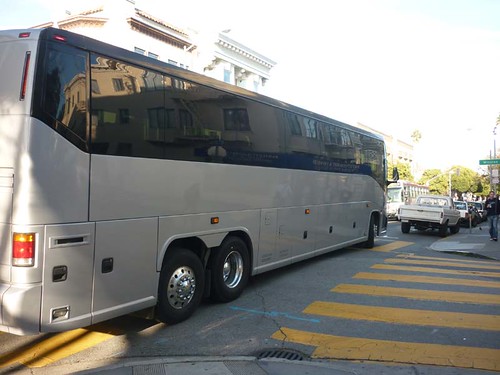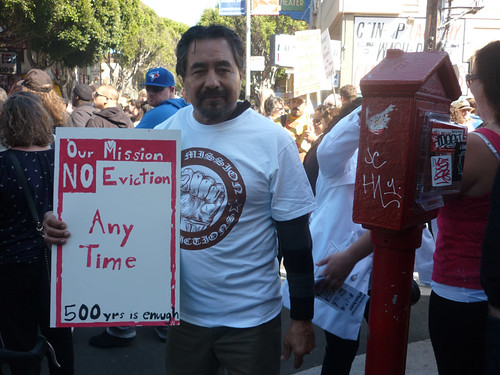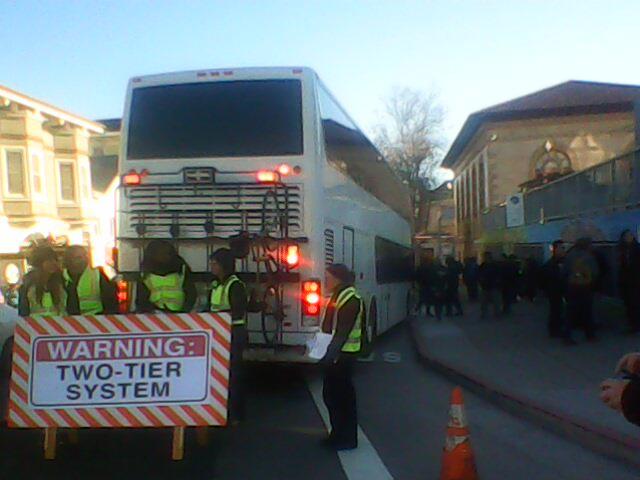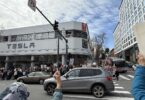Just wanted to link to a previously unpublished but oft-quoted study in the discussion about the tech shuttles’ impact on San Francisco (with the author’s permission) and write a few words about a policy committee meeting of the City & County of San Francisco’s Commission on the Environment I went to last night, to decide whether they should endorse The City’s plan to legalize the shuttles’ use of Muni bus stops in an 18-month pilot project.
First, here are the links to the full report and to the summary.
The “Google Shuttle Effect:” Gentrification and San Francisco’s Dot Com Boom 2.0
by Alexandra Goldman, MCP, Dept of City & Regional Planning, UC Berkeley
Full Report: PDF
Summary: PDF

From The “Google Shuttle Effect:” Gentrification and San Francisco’s Dot Com Boom 2.0
A bit more about that below. But now, to the meeting.
To be honest, I didn’t even know this commission existed until Randy Stortroen, one of the commentators in my Google Bus post from last year, alerted me to it. The fact that the meeting was in a small room on the 4th floor of City Hall with just a handful of chairs for the public had me thinking that I wasn’t the only SF resident unaware of this commission.
However, it was actually pretty cool to be part of the process, and three hours flew by in no time. The other big item on the agenda, Supervisor Chiu’s proposed ordinance to restrict the sale or distribution on City property of drinking water in plastic bottles of 21 ounces or less, received a good debate on how to word it so the plastic bottle industry won’t be able to finagle their way around it, and I’m psyched to see the City taking this one on.
 The headliner though undoubtedly was the pilot to regulate the tech buses that have flooded SF streets over the last couple of years or so, set to go before the San Francisco Municipal Transportation Agency’s board of directors on January 21. The proposal would allow the shuttles to use 200 of the more than 2,500 Muni stops, require them to use unique identification placards, and issue fines for violations. One weird thing is that even if the pilot is approved it wouldn’t even start until July, so we’re talking about another six months of unregulated shuttles no matter what.
The headliner though undoubtedly was the pilot to regulate the tech buses that have flooded SF streets over the last couple of years or so, set to go before the San Francisco Municipal Transportation Agency’s board of directors on January 21. The proposal would allow the shuttles to use 200 of the more than 2,500 Muni stops, require them to use unique identification placards, and issue fines for violations. One weird thing is that even if the pilot is approved it wouldn’t even start until July, so we’re talking about another six months of unregulated shuttles no matter what.
Perhaps the most controversial part of the pilot is the $1 per stop per day fee, which according to SFMTA project manager Carli Paine, who was there to answer questions, amounts to about $100,000 per year for the biggest shuttle providers like Google. Let’s just say $100k is not a lot of money for a company whose founders’ fortunes soared by $10 billion each last year, but more importantly, there are few who believe it comes even close to covering the impact the buses are having on the streets and communities of SF.
Granted, there’s a state law that prevents the SFMTA from charging a fee that goes beyond the cost of administering the program, but I doubt Prop 218, passed in 1996, foresaw a massive privately run transportation system by for-profit corporations on city streets. Also, nobody is keeping Google & Co from voluntarily pitching in a little extra just to show some goodwill towards the city whose public assets and cultural wealth they are using as a selling point to recruit young employees who don’t want to live in the suburbs. But I guess that would be like paying taxes when you could also avoid them, and what self-respecting business would do that?
As paying a fair share voluntarily seems to not be on the table, a representative from the League of Pissed Off Voters suggested that the MTA could charge a higher “impact fee” if it conducted a “nexus study,” covering things like Muni delays and housing impacts. Also, the Mayor or Board of Supervisors could put a proposed tax on the ballot. Personally I would welcome such a vote to let the people of San Francisco decide whether $1 to pull into a Muni stop is an adequate compensation. As a reminder, pulling that maneuver with a car will currently set you back $271.
 I was heartened to see that I wasn’t the only one concerned with the externalized side effects of this rapid unregulated expansion, with displacements and gentrification being the most visible ones, and the effects on public transit, the shuttle drivers’ working conditions, or the wisdom of promoting 35 mile door-to-door commutes in the first place not far behind. Almost all members of the public who showed up, including committee members themselves, acknowledged that there were too many adverse social and economic effects to simply look at this as a “taking cars off the street” only issue.
I was heartened to see that I wasn’t the only one concerned with the externalized side effects of this rapid unregulated expansion, with displacements and gentrification being the most visible ones, and the effects on public transit, the shuttle drivers’ working conditions, or the wisdom of promoting 35 mile door-to-door commutes in the first place not far behind. Almost all members of the public who showed up, including committee members themselves, acknowledged that there were too many adverse social and economic effects to simply look at this as a “taking cars off the street” only issue.
And speaking of the much-touted car and CO2 reduction claims—Google says its buses are taking 4,000 cars off the road and 20,000 metric tons of CO2 out of the atmosphere— some really good questions were asked to that effect: like how many bus riders would have chosen to move to SF in the first place if it weren’t for the buses, or what about the CO2 emissions of those displaced residents who now have to drive to get to work?
 Also, Paine didn’t have an answer on whether the numbers the tech companies are using to promote the buses’ eco cred included the CO2 emitted from their diesel fleet or whether they’re just throwing out the net numbers of alleged car trips avoided. And it’s really difficult to find out about this, because none of the methodologies for the internal surveys the tech companies and SFMTA refer to when they warn about all those people who’d be buying and driving cars if it weren’t for the buses are public, at least to my knowledge.
Also, Paine didn’t have an answer on whether the numbers the tech companies are using to promote the buses’ eco cred included the CO2 emitted from their diesel fleet or whether they’re just throwing out the net numbers of alleged car trips avoided. And it’s really difficult to find out about this, because none of the methodologies for the internal surveys the tech companies and SFMTA refer to when they warn about all those people who’d be buying and driving cars if it weren’t for the buses are public, at least to my knowledge.
One of my own questions that I’ll probably never get an answer for is about the carbon footprint that comes with the expendable income of someone who can afford a million dollars for a tiny condo, or $4000 a month for a 2-bedroom apartment that used to house someone with a teacher or bartender salary. How much fossil fuel gets burned to manufacture and ship all the stuff people with a million bucks can and will buy?
And since CO2 emissions are really of global impact, it might also be fair to ask how an entire industry that—while its intentions may genuinely be honorable—is ultimately enriching itself by enabling people around the world to buy and consume more stuff more quickly is lowering carbon footprints. Seeing that we’ve just passed 400 parts per million of atmospheric carbon dioxide with no indication of leveling off, there’s no evidence as of yet that the tech industry can solve any problems larger than where to sleep, how to get a cab, or where and how our data are accessed.
While this is most likely beyond the scope of the January 21 SFMTA meeting, I think these are valid questions, especially since CO2 reductions have been used as one of the main justifications to sanction the illegal use of public bus stops by these private companies. My question to the commission was, shouldn’t we have been discussing or voting on a pilot program of such magnitude before the oversized luxury coaches were allowed to multiply exponentially? Or as one commentator asked, if this becomes precedent, who is to keep Greyhound from using Muni stops as regularly scheduled pick-up and drop-off points?
We’ve certainly voted on much less consequential stuff in our local elections, so it’s just kind of puzzling that this kind of planned major disruption of city streets did not get any kind of public review beforehand. For what it’s worth now, I would have voted for maybe 5-10 depots strategically located around the City, accessible by public transit and perhaps smaller, citywide shuttles.
Speaking of vote, as was to be expected, the commission voted to endorse the pilot program, but to their credit they added language that this shouldn’t just be a rubber stamping of going from pilot to permanent, but that there need to be comprehensive and transparent impact studies looking into the various unintended consequences of the program.
Alexandra Goldman’s “The Google Shuttle Effect” study could be a good start. It chronicles how the rise of the corporate shuttles over the last three years has coincided with almost a tripling of Ellis Act Evictions and how rents of apartments within walking distance of the shuttle stops have gone up even more rapidly than those further away. To be honest, I was quite surprised that through all the passionate debate and protest over the past six months the study hadn’t been posted anywhere yet, so after the author confirmed that indeed it hadn’t, she asked me to go ahead and do so.
So here it is again:
The “Google Shuttle Effect:” Gentrification and San Francisco’s Dot Com Boom 2.0
by Alexandra Goldman, MCP, Dept of City & Regional Planning, UC Berkeley
Full Report: PDF
Summary: PDF
One last word to shuttle riders: I know it sucks to feel like you’re being scapegoated for problems you had no intention of causing and that may not even be the shuttles’ fault exclusively. And it must be even worse to all get lumped together into one big stereotype when each of you has his or her own unique story, background, and politics. I mean, really, we’re all pretty much techies these days, considering the amount of time many of us are sucked into the computer screens. And yes, there are larger housing and transportation issues that were there long before the shuttles.
But look at it this way—your commute has been the catalyst for a larger conversation about what we all want the city to look like in the future, perhaps even the world. It’s brought some much-needed attention to the plight of some of the most vulnerable of our fellow San Franciscans, and people are now arguing over how to best keep them in their homes rather than ignoring the evictions altogether. There’s now at least a public process in the works that might lead to a more equitable arrangement between your employers and the city, and if done right, it’ll at least ease some of the current distrust and tension. You may even be inspired to join the process.
I say that’s worth getting to work 30 minutes late and looking at a bunch of folks with funny vests and signs.
Update 1/16/2014
Here are the details about the upcoming SFMTA Board meeting:
SFMTA Board of Directors meeting, Tuesday, January 21, 2014 1:00 PM, City Hall, Room 400








i think, any proximity to a fast public transport stop (BART, CalTrain, etc) would add premium to the RE lease/price. Despite of cloaked highways in SFBA, public transport, apparently, does not satisfy SF residents’ working in Silicon Valley needs. So private companies, like Google, came up with private solution. The effect on housing, I argue, would have been the same as public transport system would have been extended in its place.
What’s so bad about it? Private money solved what public money did not, thus is the saving to the local budgets.
until we switch to socialism (and even after that it is not given), people with money would have better chance at RE market, why is it so difficult to accept? There is nothing new about it.
The only new about it is some people who were considered better off before found themselves losing that status due to success of high-tech types, so they want to hold on to their status by all means, often illegal and violent.
It remind it of difference between recession and depression as one sees it : recessions is when one’s neighbor lost his/her job, and depression is when the one lost it.
lexa, the difference is that public transport is, um, public, and so everyone living in its vicinity benefits, whereas private shuttles only benefit the people working for the private companies and the companies’ bottom line. So in the case of the shuttles driving up rents, the problem is that tech companies and employees reap all the benefits while the rest of local residents are burdened with the cost, without much of the benefits. To expand on your line, private money solved the problems of private enterprises, but created a host of new problems for everyone else. So if the private companies are not going to invest in public infrastructure and instead build their own transportation system, they should at least pay a fair share to offset the many costs they’re incurring to public infrastructure and local communities. And perhaps the public should have a say in it too, me thinks. To me, that seems just so common sensical and non-controversial, and frankly, it’s the fact that there is so little empathy coming from the tech industry and the constant “suck it up, it’s the free market” attitude (easy to tout the free market when you can stash all your money in offshore tax shelters) that is making locals just a wee bit suspicious about their motives. Then again, I’m from Germany, so that’s just the socialist in me speaking.
I’ll keep to your points:
1. “private shuttles only benefit the people working for the private companies” – fair enough, noting that those are SF residents as well.
2. “local residents are burdened with the cost” – that’s fallacy, there are no “costs”, nobody asks other local residents to pay for that.
3. “created a host of new problems for everyone else” – I can say the same about any new RE purchase\lease : they take the stock of RE avail for sale\lease and create problem for everyone else who is in the market to buy\rent. What’s new or different here?
4. “they should at least pay a fair share to offset the many costs they’re incurring to public infrastructure and local communities.”. per #2 above there are no “costs” to local communities, just people wanting their “fair share” of somebody else’s wealth. As far as cost to public infrastructure, we’re talking about Muni stops here, right? If so, the costs are minimal and may have already been covered by providing transportation benefit to their employees-SF residents.
5. “public should have a say in it” – I agree with you here.
6. ” little empathy coming from the tech industry” – what do you expect, really? I like Steve Job’s response to City of Cupertino, who tried to ask for extras when approving new Apple campus. He said to something to an extend that he was simple man and understood that he/Apple is to pay taxes City levies on them and considers their dues paid at that point; if City would not levy taxes, then he’d consider such requests… Tech companies play by the rules there are(to be sure, they are not paying fines for using Muni stops ’cause SF doesn’t sights them for that), if SF does not like its own rules, whose fault is it?
7. “offshore tax shelters” is a free market as well. USG imposes taxes on foreign profits if they’re brought into US, so companies have a choice whether to keep money out without incurring the tax or bring them in and pay it. it is a free market indeed. Some companies need those money and accept expense of taxes, others find those money other uses outside US. US can encourage or discourage capital flows in or out of it and capital would react on it in variety of ways, best fit for it, which is exactly free market.
well, I think #5 ‘”public should have a say in it” – I agree with you here’ is a good starting point for common ground as this discussion moves forward. Ironically, the only reason the public might have a say in it is because the public demanded it.
as far as no cost to local residents, having soaring rents, getting evicted, and longtime local businesses getting kicked out seems like a cost to me. Even if you justify it with free market gospel as you do, it still doesn’t change the fact that people of less economic means are paying the highest price.
as for the rest of your rather Libertarian viewpoints, I think we just look at the world through completely different lenses. To me, the supposedly “free market” is a myth perpetuated by those who already have power and money to funnel a disproportionate share of the world’s resources into their own pockets. “Free market” the way it’s currently rigged is like a marathon in which the few privileged organizers get to start at Mile 20 while the rest of us have to huff it from the start line. Want some numbers? The top 1 percent alone now own 46 percent of all global assets, with the richest 10 percent owning 86 percent of the wealth. If that is just a coincidence, I’ve got a few bridges to sell you.
http://in.reuters.com/article/2013/10/09/creditsuisse-wealth-idINDEE9980ER20131009
you can then single out people who own cars and make the same claim : their ability to commute to higher wage jobs “costs” other local resident.
then you can single out those with better education and make similar claim that they cost other resident, cause they earn more and make their cost of living higher.
Your point is indefensible, that’s outside of communist ideology.
As far a free market Libertinism, I believe Churchill once said : “Democracy is the worst form of government, except for all those other forms that have been tried from time to time.” .
I can say the same about free market, if you have better examples, please point out, ’cause I have plenty countries (all East Europe, China, Cuba, etc) with socialism rule which fared worse than those on free market order.
you have not lived in socialism, unless you’re in East Germany, i did; so I know where society where everyone is entitled to fair share of others’ successes lead… to most getting fair share of nothing, while few usurp most resources for generations to come. At least in free market, most have better chances to succeed due to own virtues than in “fair share” minded society.
well, now we’re in the sort of all or nothing parameter, where I have to choose between Capitalism Pure and Soviet-style communism. My personal preference is probably somewhere in the social market economies of what seems to be both our home country, Germany, with a progressive tax scale where the more money you make the more you pay in taxes. The market has its place, but if you are arguing in favor of a completely free market, then there would be no taxes or regulations at all.
I don’t think that’s what you’re advocating for, so the question becomes how much the well-heeled should give back in relation to the many benefits they receive from the public system (education, roads, clean air, etc) to make sure others can get the same opportunities, or at least food on the table, a roof over their heads, and universal health care. I happen to think that the tech sector is not contributing enough to San Francisco’s commons, just as I think that Mitt Romney’s or Warren Buffet’s tax contributions are completely disproportionate to the benefits they’ve derived from being members of society.
And in the local tech shuttle case, I think this is what the coming debate surrounding this pilot program is going to be about: exactly how much should a fair contribution be for their impact on the San Francisco commons. I’m sure there will be differing opinions, but if your opinion is that they owe nothing, that, um, bus has already left the Muni stop.
not sure whether you pay US taxes but IRS uses progressive tax, ask me how I know 🙂
also, you description of progressive tax is inaccurate : “the more money you make the more you pay in taxes”. The flat tax system would also satisfy your description.
Based on those 2 comments of your, I doubt you have a good grasp over tax system, let alone in US.
No, I do not argue for no taxes or regulations, free market may have them.
I do not know whether Buffet and Romney pay enough taxes, we cannot charge them tax assuming the benefits they received from the society in past, we have no law to that extend. We can only charge them as much as they consider worthy for their tax residence to remain in US, there is always a level of taxation after which they would consider it unworthy. Just ask Gerard Depardieu.
As for tech sector, I do not think it owes SF or SF owes it, beyond current laws/taxes. As we know, in business past favors mean little, it is all about future considerations. Do not forget, the SV tech companies are not your relatives or friends, they are businesses, their owners compete with you for resources in life.
SF can change it laws any day (it is democracy after all), then tech sector would adjust, it may result in tech workers exodus from the city (or not), would benefit the City (or not) … the future would tell, none can predict the future. Detroit was once very prosperous city, for example.
you’re right, I’m not intricately familiar with U.S. nor German tax code. But I do understand a progressive tax code, so let me be more concise in my statement: “the more money you make the higher rate in taxes you pay.” To take the Mitt Romney example, while he gets away with I think paying 13% in income tax, in Germany he would probably pay closer to 50%. And he would also have to declare his overseas investment earnings, which I think is something the IRS has been getting stricter on the last few years. But the basic point is that the rich pay a much lower rate in taxes in the U.S. than in most other western democracies.
Yes, as far as your second point, SF changing its laws is basically what we’re talking about here. Nobody is claiming that the tech companies are doing anything illegal by law (if you’re discounting the fact that pulling into a Muni stop is illegal, but since they were basically given permission by the SFMTA, the public is taking it up with the SFMTA). So we’re totally in agreement as to how this will have to play out, and all my post does is describe that this is indeed happening while also making the case for why the user/impact fee should be much above $1 per stop per day. Others such as yourself will perhaps argue for less or nothing at all, but that will be democracy in action, for better or worse.
To address the public vs. private issue, one unintended consequence that I have a problem with is that the development of the private system lessens the need for the improvement of the public system. I am a public high school teacher who lives in SF and commutes to San Mateo by car everyday. I would really rather take public transportation, but by the time I ride my bike, account for MUNI delays, and get on Caltrain, it becomes too much of a hassle to do it. Wouldn’t it be nice if we had the political and financial capital of all these new SF residents to help us put pressure on our public servants to improve the public system? Too bad that I can’t also hop on the google bus…
I think that’s another big point that often gets ignored. How many passengers is CalTrain losing because of the buses, and what does that do to their operations, not just in terms of maintaining service but perhaps expanding? I’ve heard people advocating for CalTrain to modernize their trains to be electric and have more frequent service, but if there’s now less incentive to take the train in the first place there’s no way to justify or fund such an improvement. If the tech companies were to invest in public transit instead of thwarting it, that would be an amazing contribution to the common good. And yes, I know, they’re not legally required, but for an industry that basically lives off the image of making the world a better place, it would be more true to their proclaimed mission.
So many more important things to be worried. How about the congestion that it takes off the road or freeways? Get a life!
As nice as it would be, we’re well past the point of being able to eliminate tech buses. What we can do now is try to mitigate the effects to the general populace. Approximately 45,000 workers live in San Francisco but work in the Silicon Valley and transit back and forth every day using some manner of shuttle. There are over 800,000 residents in San Francisco proper. These buses block MUNI buses, have blocked school buses at Mission High, pollute the center city with diesel fumes, cause a huge risk to cyclists when they block the bike lane and force them into traffic blindly at certain intersections, and as you see now, raise the rents of people living along their routes.
My solution is that these buses should only be able to pick up and drop off from a central terminus. The terminus would be connected to public transport and directly accessible to the highway so as to keep them off the streets. In this case, the Transbay Terminal in the city and Colma BART further south would be well-served for this purpose. For the riders living in San Francisco, nothing is more than seven miles away from anything else, so they could easily take public transportation or walk to the terminus, and pick up their shuttles to their valley campuses. The current solution of the $1 fee contributes absolutely nothing to the SFMTA, whose system is directly being impacted by these buses. The fee simply pays for oversight committees to make sure people are paying the fee and that buses are displaying their license. This is a stalling technique.
As it stands, we are impacting the greater populace for a group of people who comprise 5 percent of the population of this city. A central terminus would serve the greater good by getting these buses off of city streets for all the reasons I’ve already indicated.
In addition, it takes the very totem people take with such derision away from the streets, which can only help us really get to the root of the issues with housing, renter/tenant/landlord right reforms, and income inequality.
I couldn’t agree more with you, Josh. You should present your common sense proposal at the SFMTA meeting on January 21st.
I was there, but I had been sitting in that hot room forever by the time I got to speak, and I was pretty nervous. I don’t even know if I made all of my talking points, but I did tell them they need to look into a central terminus.
It was really hot in there, wasn’t it? And as far as nervous, I felt that too. Not used to speaking in public, and thought I was rambling too much. But I think they ultimately got the point that a lot of people have concerns about this pilot and the whole deal. Not that it matters, as the SFMTA Board approved the pilot today after 2/3 of the public raised concerns.
SF cannot drive corporate buses away from SF street unless it outlaws all other buses and, perhaps, tracks from the streets (otherwise it would not stand any court challenge). Doing that may jeopardize Federal funds for SF roads. So it is pretty much non-starter.
The only real leverage SF has is Muni bus stop uses. You suggest to effectively to ban this corporate buses from Muni stops (as BART and Transbay terminal are moe than those). Once SF has done that, it lost all practical leverage over corp bus operator and they’ll find non MUNI stops pick up points in the City on their own.
well, they would have a hard time finding 200-250 non-Muni stops where they could legally pull over to load and unload. They actually tried that, double-parking and pulling into bike lanes, but that wasn’t very well received and is, in fact, illegal. So the only way they can maintain their current system legally is for the City to allow them to use public bus stops. Which brings us back to how much that privilege is worth. Nobody else gets to do it without receiving a $271 ticket.
And just so you know, other enterprises are getting reigned in too. For example, the tour buses that used to pull over anywhere near Alamo Square, recently got relegated to just one agreed-upon loading zone on Fell and Pierce.
http://www.sfgate.com/bayarea/article/S-F-bans-large-tour-buses-around-Alamo-Square-4994596.php
of course, they won’t find 200, but they would find at least 1, which renders Josh’s suggestion to limit them to “Transbay Terminal in the city and Colma BART” as a non-starter.
The Mayor’s Task Force proposes contributing only 4% toward the funding to complete the downtown extension to Transbay terminal, which will greatly improve San Francisco residents’ access to Caltrain. That’s not the fault of the Google bus.
FYI, Lexa is a troll. Do not feed the trolls.
One of the problems with Google using Caltrain service is actually in Mountain View – the route the shuttles take from the Caltrain station is convoluted and congested, and takes 30 minutes instead of 10 minutes clear. Google is working with Mountain View to improve the route for the train station shuttles, and then the train will be 15-20 minutes more time-effective for employees.
Also, I don’t get the concern about the real estate being bid up on the bus routes. Housing with access to BART has had extra value for decades. It’s not a surprise, and in fact it’s a good thing that people want to live with access to good transit. The issue is anti-displacement policy and being willing to add supply where people want to live.
Also, imagine SamTrans, VTA and Muni got their acts in gear and ran efficient public express bus service from San Francisco to Silicon Valley. Those routes would also put pressure on housing prices. The answer isn’t to keep public transit slow and inconvenient.
“The answer isn’t to keep public transit slow and inconvenient.”
Agree 100%. But I think that if the tech sector had worked a little bit harder and offered to put some of its tremendous wealth and good intention into improving Muni, CalTrain and other public transit, there would be so many more long-term benefits for the Bay Area as a whole than just a few cars taken off the road by tech workers. (And even that claim is questionable as their own survey says that 40 percent of S.F. shuttle riders would move without chartered bus service. Also, what about the cars and carbon footprint of the people like these teachers who are either evicted or priced out of their SF neighborhood and are now driving from their new homes into the city? Plus, now fewer and fewer tech workers even have an incentive to take CalTrain anymore, making deficient public transit even more of a self-fulfilling prophesy.
The one good thing that is coming out of this pilot is that there finally will be some public accountability of these shuttle programs, with some real impact studies that will hopefully take some of the factors into consideration that so far have been conveniently externalized.
The difference of rising real estate between building a public transit stop and a private one is that in the former everyone shares the increased cost as well as benefit, whereas in the latter only a few benefit while everyone else is burdened with the cost. That, and the lack of communication and public dialog before launching such a private program with such a huge effect on the public is what’s really troubling. Imagine how many public reviews and impact studies there are before a new BART station gets approved. And yet here we have the SFMTA set up a program where hundreds of huge buses stop in 200 public transit stops across very narrow city streets, and basically nobody was notified beforehand.
I have mixed feelings about the shuttle bus deal that the city seems to have made – charging for bus stop use in the pilot project. It’s a bit like making a deal with the devil. The devil wins the moment we start speaking its language, which in this case, is money. 100K is nothing to tech companies, like you said. It’s an investment with huge returns for them in terms of legitimizing their operations and ambitions. They wouldn’t be doing it if it wasn’t worth it to them.
They are good with playing sleight of hand with data and statistics so glad to hear folks are asking tough questions about the real impact of their buses. And I really like the questions you raised about the disposable income of high paid junior engineers. Even those who don’t spend a whole lot park their money in mutual funds that invest in commerce and production, “growth” industries like shale drilling companies. There’s no escaping the fact that once we’re plugged into the economic system, it draws us in a whole lot more than we want in.
I like that “WARNING: Two tier system” sign 🙂